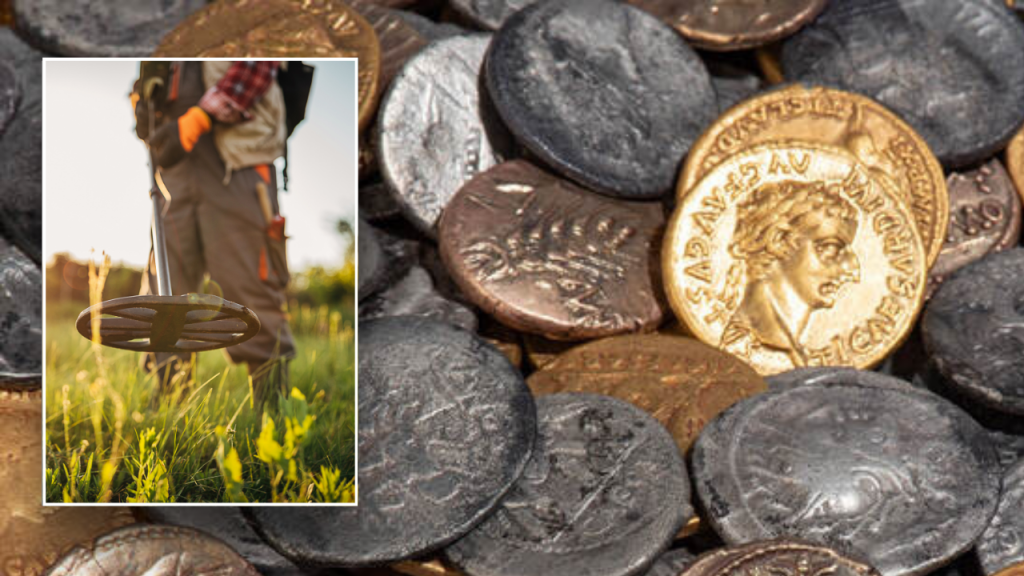In the autumn of 2023, two metal detectorists, Gert-Jan Messelaar and Reinier Koelink, unearthed a remarkable hoard of 404 gold and silver coins in Bunnik, a town within the province of Utrecht in the Netherlands. This extraordinary find, kept under wraps for months, was finally revealed to the public by the Cultural Heritage Agency of the Netherlands in January 2024. The cache, a unique blend of Roman and British coinage, offers an unprecedented glimpse into the historical interactions between these two ancient civilizations. Its discovery holds significant implications for understanding the Roman military campaigns in Britannia and the economic and cultural exchanges that occurred during this period. The find’s location along the Lower Germanic Limes, the Roman Empire’s northern border, further underscores its historical importance.
The hoard comprises two distinct groups of coins: 42 British “staters” and 362 Roman coins. The British staters, minted between 5 B.C. and 43 A.D., are composed of gold, silver, and copper. They bear inscriptions of Cunobeline, a British king who reigned from 9 to 43 A.D. These coins offer valuable insights into the political landscape of pre-Roman Britain and the reign of Cunobeline, a prominent figure in British history during the early Roman period. The presence of his name on the coins suggests their circulation within his kingdom and potentially their use as tribute or spoils of war following Roman incursions.
The Roman coins, numbering 288 silver denarii and 72 gold aurei, span a period from 200 B.C. to 47 A.D. The most recent of these Roman coins date to the reign of Emperor Claudius, who oversaw the Roman conquest of Britain in 43 A.D. Interestingly, some of the coins show no signs of wear, suggesting they were never circulated. Two gold aurei, minted with the same stamp, appear to have come directly from a fresh batch of coins, indicating the owner likely acquired them directly from the mint. This detail offers a fascinating glimpse into the economic practices of the time and the potential wealth of the coins’ owner.
The unique combination of Roman and British coins within a single hoard, discovered along the Roman Empire’s northern border, represents an unprecedented find on mainland Europe. While similar discoveries have been made in Britain, this is the first instance of such a combined hoard being found on the continent. This fact elevates the Bunnik discovery to a position of international significance, as it provides tangible evidence of the interplay between Roman legions and the native British population during the early stages of the Roman conquest.
Experts hypothesize that the coins belonged to Roman soldiers returning from campaigns in Britannia. The Roman coins likely represent their pay, while the British coins likely represent war booty acquired during their service. This interpretation aligns with the historical context of Roman military expansion into Britain and the common practice of soldiers accumulating wealth through both their wages and spoils of war. The hoard’s burial suggests the owner intended to retrieve it later, perhaps indicating a sudden departure or unforeseen circumstance that prevented them from doing so. The discovery not only sheds light on the individual soldier’s experiences but also contributes to a broader understanding of Roman military logistics and the movement of wealth within the empire.
The discovery reinforces the Lower Germanic Limes’s crucial role in the Roman conquest of Britain. This frontier region served as a staging ground for Roman military operations and facilitated the movement of troops and supplies across the North Sea. The Bunnik hoard provides tangible evidence of this dynamic, connecting the continental Roman military infrastructure with the campaigns in Britain. It underscores the interconnectedness of the Roman Empire and the flow of both people and resources across its vast territories. This discovery also establishes the region of Utrecht as a significant archaeological site, providing valuable insights into the era of Roman expansion and the complex interactions between the Roman Empire and the indigenous peoples of Britain.

